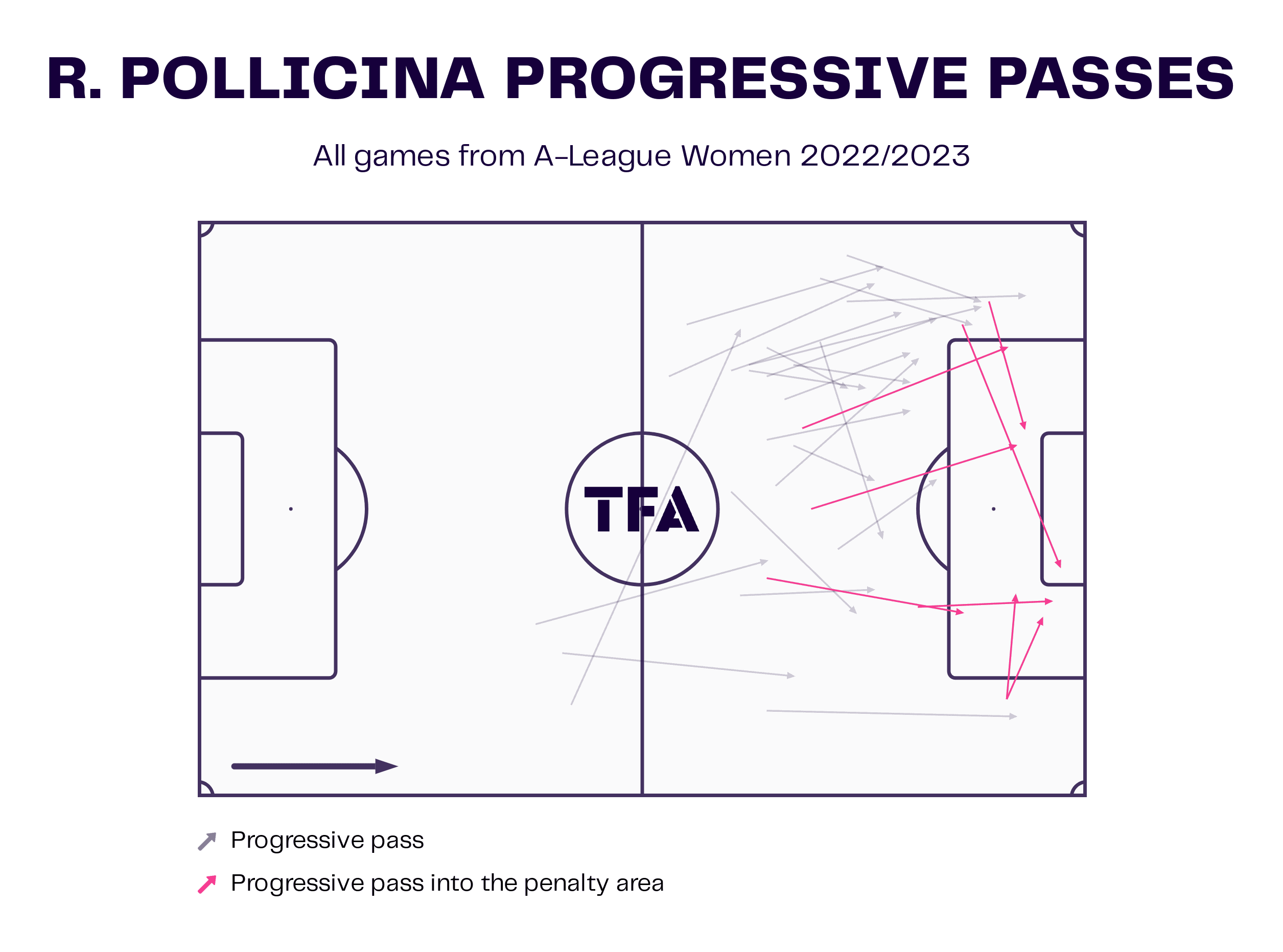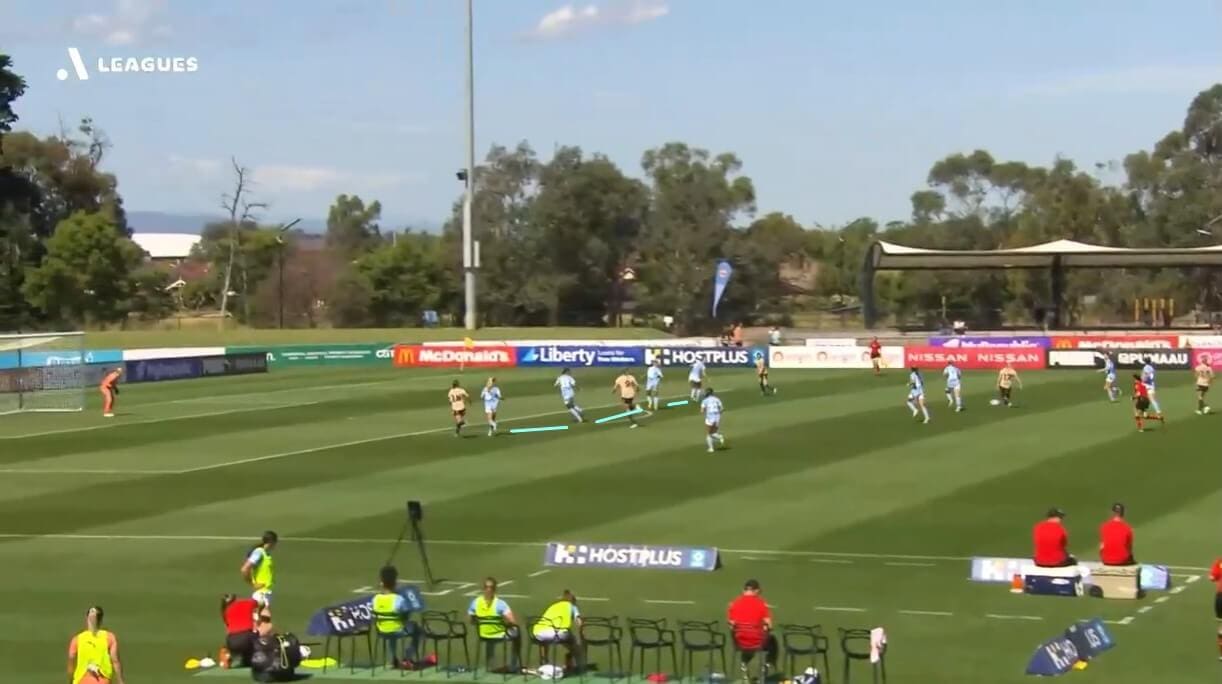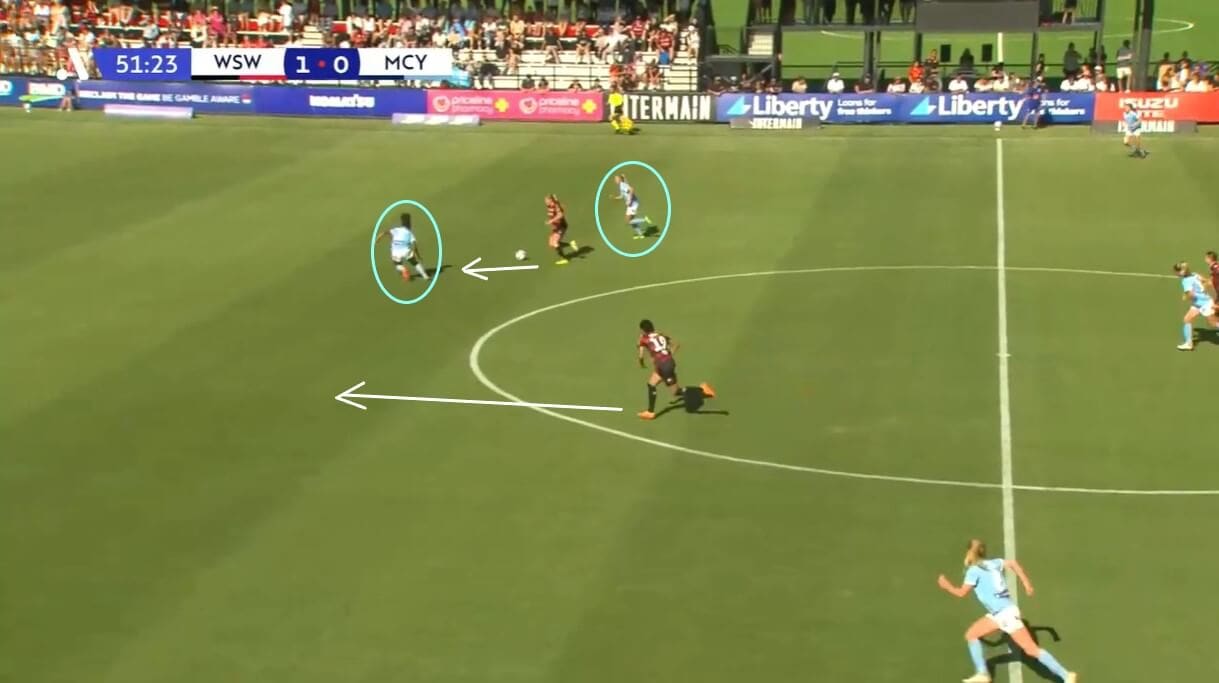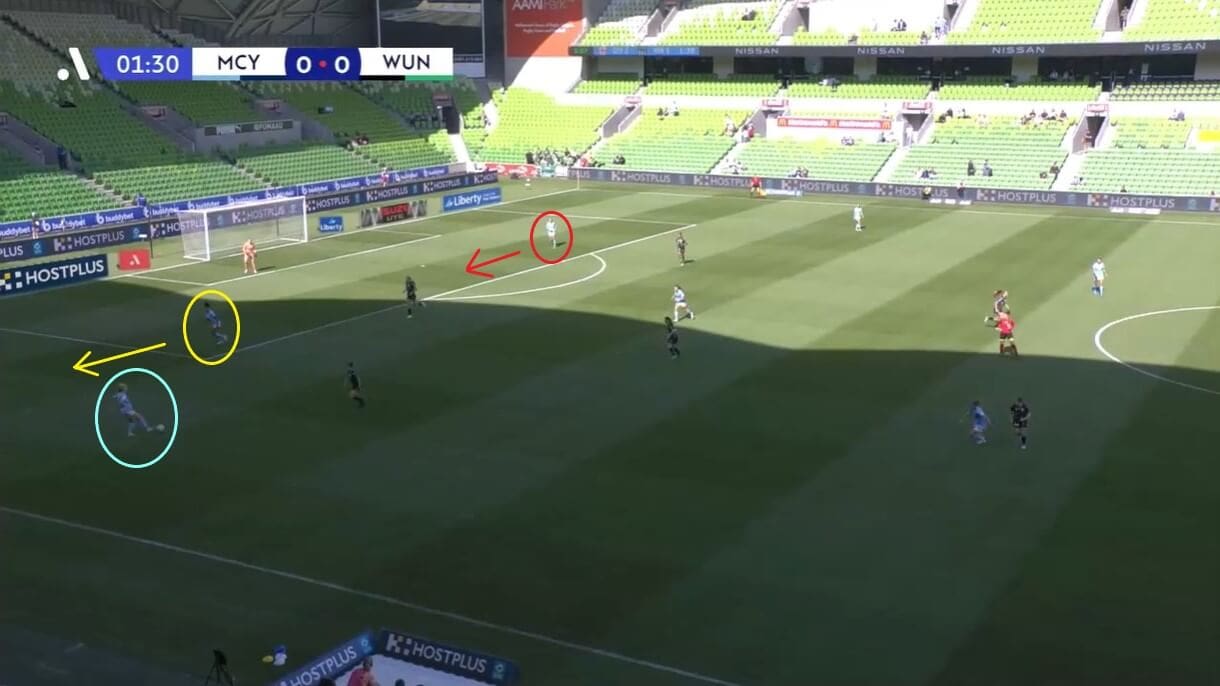Christmas is a time when most football fans can sit back, take a breath and reflect on the events of the first half of the season, with players and coaches allowed to enjoy some downtime and recharge ahead of title run-ins or relegation battles. However, not all leagues take the festive period off, with one of those in the women’s game that keeps going throughout being Australia’s top flight, the newly-renamed A-League Women. It is always an exciting league to keep an eye on, with the 2022/23 campaign being no exception, as three teams sat level on points at the top of the table after eight weeks of matches.
As a result, it was a case of who would blink first, and, as it turned out, Melbourne City Women were the side who suffered the first major slip, with them picking up a second loss of the season at Western Sydney Wanderers Women last weekend whilst both defending regular season champions Sydney Women and league newcomers Western United Women registered maximum points.
However, despite their setback, the side owned by City Football Group (alongside the men’s team) should not be underestimated, with them finishing second in the regular 2021/2022 season before losing out in the semi-finals of the latter stages, and the fact that they have the likes of current Arsenal Women duo Jen Beattie and Kim Little, Scotland’s ex-Everton Women forward Claire Emslie (now with NWSL side Angel City) and Manchester City Women’s Alanna Kennedy among their former players indicates that talented names have believed in their potential.
This season, they have been the most potent side in the division so far with 18 goals to their name, which is a big positive for them. However, what will concern their fans is their inability to keep teams out, with their record of seven goals conceded currently being the worst record in the top four, and there are fears that that leakiness might leave them short once again. With that in mind, whilst this tactical analysis will discuss the many positive aspects of their play, it will also examine why they have lacked defensive security and where they can tighten up as the season progresses.
Wing play
One common way that Melbourne City Women build attacks is by using the wings to give them passing options, with their favoured 4-3-3 system allowing the wide forwards to make runs behind opposing defensive lines and into spaces from where they can create goalscoring opportunities.

This gives interim manager Dario Vidošić’s side targets to find when they look to play long balls up the field, meaning that they have a better chance of keeping possession and not allowing their opponents to send the ball back into their half. As a result, they can put pressure on defensive lines, with them now knowing that they have to get every detail right or Melbourne will have a free route to goal, and the positioning of close-season signing Bryleeh Henry here against Canberra United Women highlights how not winning the ball or not turning in time should it go behind them will allow Melbourne to get a shot away at goal.
It might look as if this is just Henry being clever with her positioning, and it is true to say that she has been one of Melbourne’s biggest threats this season, but the fact that her movements are often mirrored on the other side of the pitch indicates that it is actually part of Melbourne’s overall game plan, helping them to get on the front foot as quickly as possible and to commit numbers up the pitch, and getting all of that right is one reason that they have been so potent in front of goal.

However, it is not only the wide forwards who take up these positions, as the full-backs are also tasked with pushing up the field and controlling the wings. By doing so, they allow the two wide attackers to cut inside and work in closer proximity with the striker, which again helps Melbourne to get numbers into central areas and pose as big an offensive threat as possible.
In order to play this way though, Melbourne need to have full-backs in their team who can attack and defend with equal ability, otherwise they will either lack attacking support or leave themselves too open once they lose possession. However, fortunately for them, they do have players in those positions who can do both, with Kaitlyn Torpey and Chelsea Blissett both known for their speed around the pitch and ability to sit back or set up shots on goal. In this case, Blissett is looking to run into the area behind Western Sydney, just as Henry was in the previous image, and is able to make a cross into the goal area before Beth Gordon can get back to block it.
On this occasion, Alexia Apostolakis clears the threat and saves her team, but the fact that Blissett was making the run into the space is the key point, as it shows how much Melbourne value those areas of the pitch and how vital they are to helping the team to stay on the front foot.

However, what has often let them down is the final pass or cross, with them often lacking quality and making it too easy for their opponents to regain possession and to clear their lines. In the last image, Blissett’s pass was intercepted easily by Apostolakis, and this situation shows the ball in a similar position and Melbourne once again looking for a way to transfer it into the middle.
The two options available this time are experienced Chile striker María José Rojas, who is in the middle, and Henry, who is on the other side of Western United’s defensive line, and both are ready to receive the ball. However, this is where decision-making comes in, as Melbourne need to send the ball towards the right player in order to give themselves the best possible chance of converting the opportunity. In this case, a longer pass towards Henry is the better option to take, with Western United’s narrow defensive line concentrated around Rojas’ position, making it difficult for her to control the ball and shoot at goal.
However, this is not what happens, with the ball being sent along the ground towards Rojas, which plays straight into Western United’s hands as Alana Cerne is able to easily clear her lines. The fact that they only have a 26.3% crossing accuracy highlights how this is not the first time that they have lacked quality with their passes into the middle, and it is an area that they will need to improve as the season progresses, as not making the most of these chances will cost them in the long run as they fail to win games and so drop valuable points.
Creating chances
That lack of potency is however one of the reasons that Melbourne City Women don’t solely rely on their wing play in order to create chances, and their ability to adapt and play in different ways is one thing that Vidošić highlighted at the beginning of his tenure as something he wanted to keep developing as the season goes on.

This is where their 4-3-3 system again comes into play, with it allowing their midfield in particular to move around the pitch and take up different roles as they try to find alternative ways of moving the ball up the field. Here, Leticia McKenna has possession and has initially looked like taking it infield, with Canberra trio Laura Hughes, Nikki Flannery and Kennedy Faulknor watching her movement closely.
However, this is only a ploy by McKenna, as she is actually looking for a way to transfer it into the space behind those three players, and the run of captain Rhianna Pollicina provides her with the perfect opportunity to do just that. Melbourne as a team have demonstrated a high level of precision when they do move the ball around the pitch, not only aerially but also across the ground, and the fact that their passing accuracy currently stands at an impressive 80.5% highlights that, and it is worth noting that neither Hughes, Flannery nor Faulknor were able to intercept the ball here despite it travelling through the middle of them.

Pollicina has always been an important player for Melbourne to have on the pitch, but she comes into her own when her side are forced to keep the ball on the ground and play through their opponents. As this graphic illustrates, the playmaker has a wide range of passing and has been at the heart of a lot of their creativity this season, with the number of arrows indicating how often she gets on the ball and how she plays an important role in keeping her team on the front foot.
The fact that each of these passes starts from a different position is also important, as it highlights once again how Melbourne’s players are given licence to move into different areas of the pitch, making them less predictable to play against. Therefore, when it comes to identifying players that play an enormous role in Melbourne’s ability to operate in different ways and pose a threat with each one, Pollicina is undoubtedly someone that they can’t be without.

The other thing that keeping the ball on the ground gives them is an added level of teamwork, with the midfielders moving around the pitch and operating more closely with the forwards, and that ensures that there are always players in space who can receive the ball and either pass it onwards or take a shot on goal. Here, on-loan Racing Louisville forward Emina Ekic has received the ball but knows that she does not have time to turn towards the Canberra goal, as doing so would put her under instant pressure from the defenders and would almost certainly lead to the attack coming to an abrupt end.
As a result, she uses the fact that the defenders are focused on her to look for options, and has spotted the run that midfielder Daniela Galic is making in her direction in order to give Melbourne a way of keeping the chance alive. Had the midfielders remained in a rigid structure, which some teams do maintain when in a 4-3-3 setup, then this might not have been possible, so that shows again how Melbourne’s free style of play is a big positive for them.

Creating chances is a whole team effort though, and that includes the two centre-backs, who are also expected to help move the ball around the pitch and into areas where the opponents can be put under pressure. Again, this requires players who have specific qualities, and Melbourne have identified players who fit the profile that they are looking for, with both Naomi Thomas-Chinnama and New Zealand international Katie Bowen showing themselves to be ball-playing defenders with a wide range of passing.
In order to use their abilities though, Melbourne have to play in a risky manner, with them tending to push their back line as high up the field as possible when they have the ball, as is shown here, and risking the high possibility of counterattacks catching them out. However, positioning the defenders inside the opposing half means that, when the ball comes to either of the centre-backs, they can deliver forward passes with more accuracy, either finding the forward line directly or sending the ball into the midfielders, depending on the situation.
It is also worth pointing out that the knock-on effect of the defenders getting this far up the field is that the midfielders can stay higher up the pitch and don’t need to drop back as often, which gives those with the ball additional targets to find but also fits in with their overall tactics in that it gets numbers into the final third.
Defensive issues
However, whilst a lot of Melbourne City Women’s forward play is positive, the same is not always true when it comes to their defensive play, with it being mentioned at the start of this analysis that they have conceded the most goals in the top four at time of writing, leading to them picking up two defeats and sitting three points behind current leaders Sydney.

When they do have time to set up with a solid defensive shape, Melbourne are often difficult to break down, with their narrow structure here making it hard for Newcastle Jets Women to get the ball into either Tara Andrews or Lauren Allan and instead forcing them to roll the ball into the goalkeeper’s path. Against Newcastle, remaining compact is really important, as Allan in particular has demonstrated this season that she will score goals if given any space to roam in by opposing sides.

However, the problem is that they have more often than not lacked that level of organisation, which is often due to their defenders moving up the pitch to assist in their attacking play, as mentioned in the last section. As a result, when they make mistakes in possession, which they have done on a number of occasions, they are often left open and it has been easy for opposing attackers to take full advantage. Here, the danger has come through Bowen losing the ball from a throw-in, with Western Sydney instantly moving forwards and looking to get a shot away at goal.
On this occasion, when Sheridan Gallagher sent the ball into the path of Sarina Bolden, the Philippines forward was unable to get her effort on target, letting Bowen and Melbourne off, but this is not the only time that individual errors have let opposing sides run at their goal and it shows how they have been their own worst enemies at times.

The other issue that Melbourne have had at times is that their aforementioned ability to move around the pitch has left gaps open in their lines, with players often making one movement too many and leaving each other exposed and easy to beat.
Here, they have a good initial setup, with the defensive line stretching across the pitch and making it as big as possible, but Chinnama sends the ball towards Torpey and then decides to follow it, with her taking up a position in the space just behind her teammate, as the yellow arrow indicates. By doing so, she catches both Torpey and Bowen out, with the full-back’s pass back across the pitch giving Western United the ball inside Melbourne’s third, whilst Bowen is unable to react in time and so finds herself outnumbered in her own goal area.
The result is that midfielder Adriana Taranto is able to control the ball and send it through the gap, finding the back of the net, and Western United deserve credit for the way that they made the most of their opportunity. However, it was another occasion where Melbourne left themselves too open and made it easy for their opponents to score, and they will know that this goal could have been easily avoided.
Conclusion
In conclusion, this tactical analysis has looked in detail at Melbourne City Women, focusing on the positive aspects of their play and where they have made costly mistakes which have seen them drop points. What has become clear in this scout report is that they are a team who can play in different ways and the fact that they are able to adapt means that they will always be in contention for major silverware. However, in order to get their hands on the trophy, they will need to tidy up the areas that are currently letting them down, with their decision-making often showing signs of weakness and their defensive errors putting them under unnecessary pressure.
When Vidošić took the job, he told fans that his side were “going title hunting”. At the moment, they are simply looking to secure a top-four position, but there is still a long way to go yet and anything can happen.





Comments